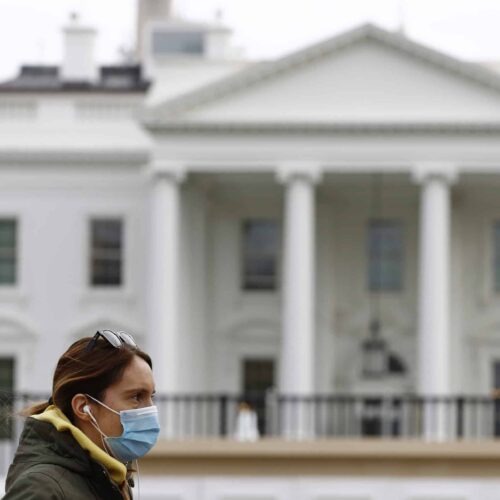Introduction
Hi Watchdogs, and welcome back to your favorite newsletter.
This week, we have another scoop on White House Coronavirus Task Force leader Dr. Deborah Birx’s latest call with state and local leaders about the state of the pandemic, the reason why workplace deaths are on the rise and pilots fighting robots. Let’s get into it.
What the White House doesn’t want you to know: The state of the pandemic.
Every week, the White House Coronavirus Task Force issues weekly reports to governors about the current state of the pandemic but keeps these reports out of sight from the public.
We’re changing that.
Yesterday, after we shared Kentucky’s state report with 100 local outlets, journalists there closely questioned Gov. Andy Beshear on why he went against WH Task Force recommendations to re-open bars in late July.
We’re collecting the secret reports, making them public and updating them as new information comes. So far, we have Arkansas, Kentucky, Oklahoma, Oregon, Utah, Vermont and Washington. Take a look at what we found so far.
This week, Birx recommended that universities test students returning for fall classes as well as set up “surge” testing, or testing thousands of samples a day, during a private call with state and local leaders.
In a recording of the phone call that we obtained, Birx said that in addition to “surge” testing, each university should also do entrance testing.
The kicker: It doesn’t seem like the Centers for Disease Control and Prevention got the memo.
The CDC doesn’t recommend entry testing for all college students and staff because the method hasn’t been “systematically studied.” The advice from Birx came after coronavirus outbreaks forced the University of North Carolina at Chapel Hill and University of Notre Dame to revert to online classes.
Shout out to UNC Chapel Hill’s student newspaper the Daily Tar Heel, that published an editorial saying students saw this clusterf**k coming.😬 Their words, not ours.
Related: The Atlantic writes about a group of epidemiologists and economists who think a COVID-19 testing technique called “pooling” could get a few hundred thousand more tests out every day. (via The Atlantic)
Our ad-free, paywall-free reporting saves lives. Chip in to help keep our journalism going.
We can’t do this work without your support.
The Occupational Safety and Health Administration, the federal agency that enforces workplace safety laws, cut back on inspections, even though job accidents and deaths are on the rise.
Our analysis shows that even though the labor force grew by 16%, the number of workplace inspections dipped during the first three years of Donald Trump’s presidency –– then nosedived during the coronavirus pandemic. A vast majority of deaths and catastrophes have occurred at workplaces that weren’t inspected by OSHA. We have the full investigation here, part of our series with Vox on the Trump administration’s deregulatory agenda.
What else we published this week: Our story on an artificial intelligence algorithm that squared off against an F-16 pilot is probably the closest thing you’re going to get to humans versus robot action this week. By the way, the AI won.
What we’ve been following:
- This week was the Democratic National Convention. If you missed it, here’s some analyses on Joe Biden’s speech and on Kamala Harris’ official acceptance of the vice presidential nomination. The New Yorker and NPR also share some good takeaways.
- This week was also the 100th anniversary of the ratification of the 19th Amendment, which gave women the right to vote. Some women, that is. We have an analysis from our CEO Susan Smith Richardson on how the primary beneficiaries of the amendment were white women with money.
- The Marshall Project also reported on nearly 37,000 formerly incarcerated Louisianians who recently had their voting rights restored by the state legislature, and whether they will be going to the polls this November.
It’s been more than a month since we first broke the story of the White House Coronavirus Task Force’s unpublicized documents.

For this week’s Q&A, we spoke to Ryan Panchadsaram, former Deputy Chief Technology Officer of the United States under President Barack Obama and co-founder of COVID Exit Strategy, a website that tracks each state’s progress dealing with the pandemic. Last week, Panchadsaram filed a FOIA lawsuit to request the task force’s reports be made public. But the estimated date of completion for his request isn’t until June 16, 2023 (yes, you read that right).
*Interview lightly edited for brevity and clarity.
What made you file the FOIA lawsuit? What are you hoping to accomplish?
I believe the White House is being irresponsible and truly negligent not to share this document with the public. This painstakingly prepared document gets distributed to our 50 states’ governors, with specific recommendations for curtailing the spread, along with progress reports on testing and county-by-county assessments of the prevalence of the virus.
But nobody else has access to it. We only get access because of leaks from organizations like yours.
Can you give a specific example of how this data could help?
One example: Kentucky’s official dashboard does not share positivity data by county. This is a critical measure to understand if it is safe to reopen schools, offices and other public spaces. Guess where this data is? It is in the White House Coronavirus Task Force reports!
Every leak of these reports leads to both national and local coverage of the critical public health information within it.
Is Kentucky doing something intentionally malicious? Probably not. Aggregating this data can be difficult for a state to do. Having another source of data helps complement — and quality check — what a state can produce on its own. More public data is always better. And data shouldn’t be partisan — it should be a public resource.
What’s the story behind COVID Exit Strategy? What are you guys trying to accomplish?
COVID Exit Strategy is meant to be a progress bar for how the country is doing on tackling COVID-19. Our team is made up of public health and crisis experts with previous experience in the Trump and Obama administrations. We grade states on such critical measures as disease spread, hospital load and the robustness of their testing.
We primarily get this info from the COVID Tracking Project, (a volunteer group run out of The Atlantic) and the National Healthcare Safety Network, run by the CDC.
Our goal is to influence and inform state leaders. Companies use our data to determine office openings. Federal agencies use us, too. We’ve had over a million visitors since May. We did this as a way to help, but I don’t think everyone expected us to perform this function for as long as we’ve had to.
If the White House reports were public, it would put us out of business. And we’ll be happy.
That’s all we have for you, folks. If you’re interested in how nonprofit journalists are tackling the issue of racial equity in the newsroom, our CEO Susan Smith Richardson is speaking on a panel put together by the Investigative New Network. Register here. See you next week.
Read more in Inside Public Integrity
Watchdog newsletter
Words matter: Was the attack on the Capitol a rally, protest or insurrection?
The question remains how history will record the events that resulted in mayhem at the U.S. Capitol.



Join the conversation
Show Comments